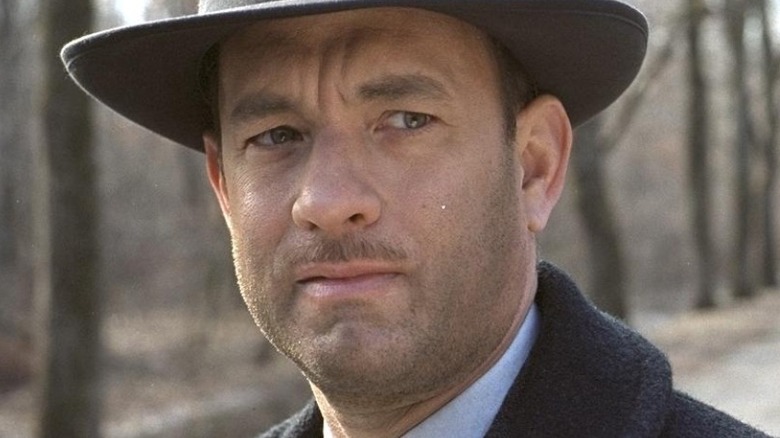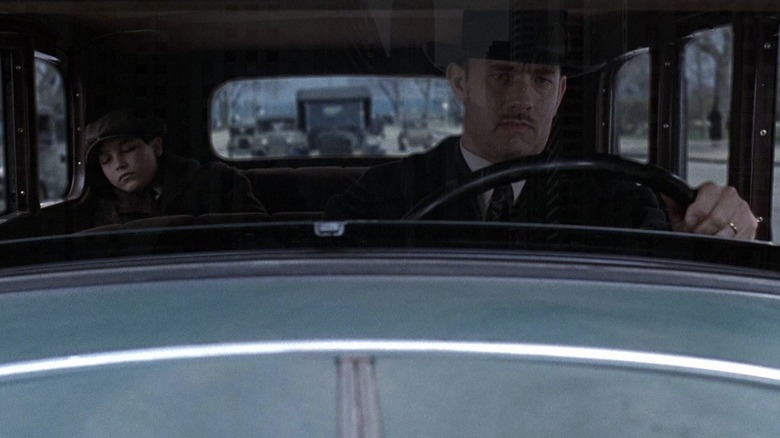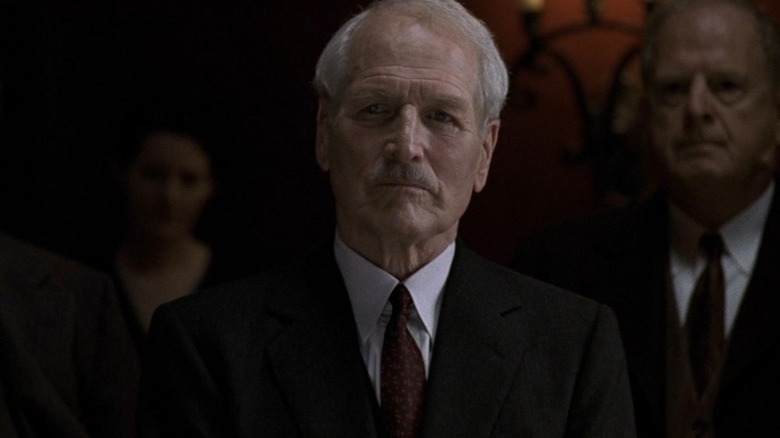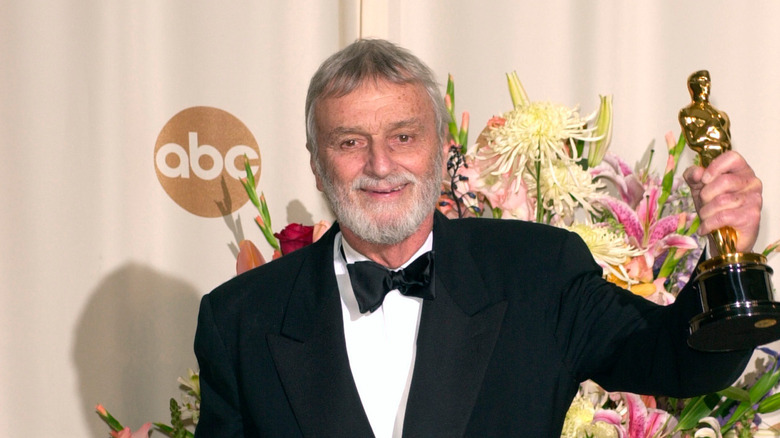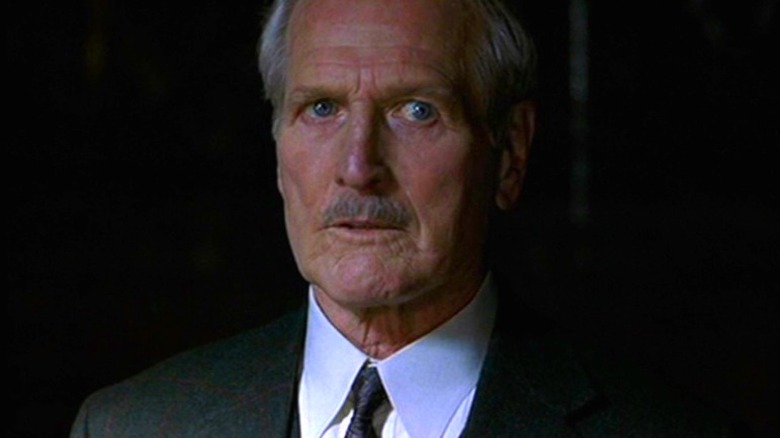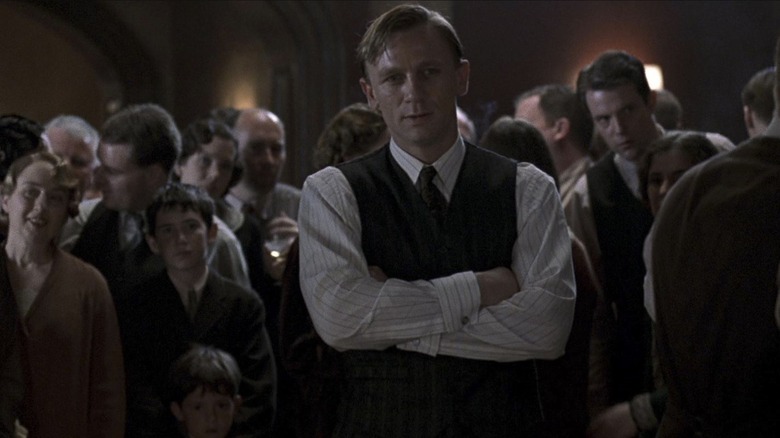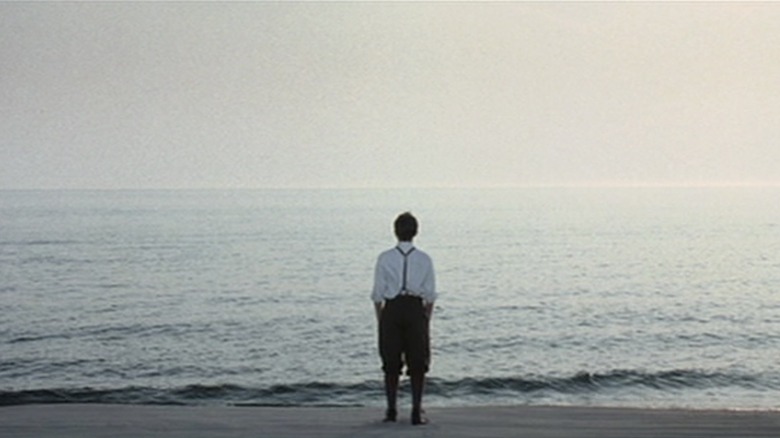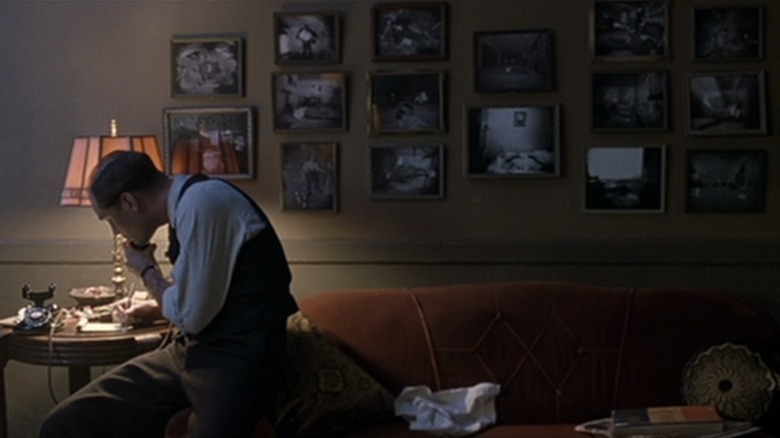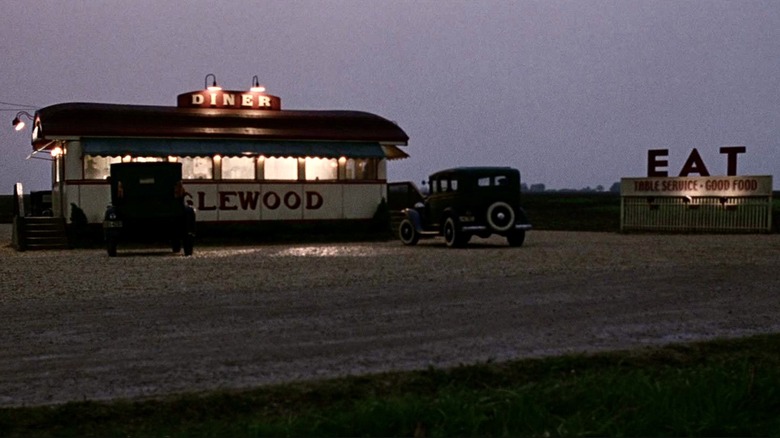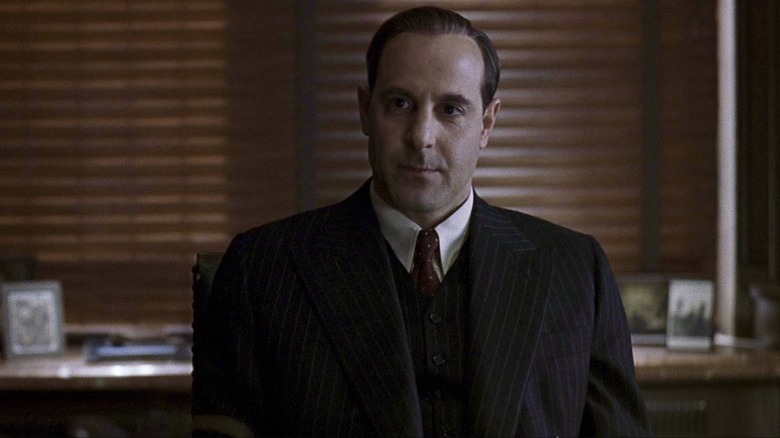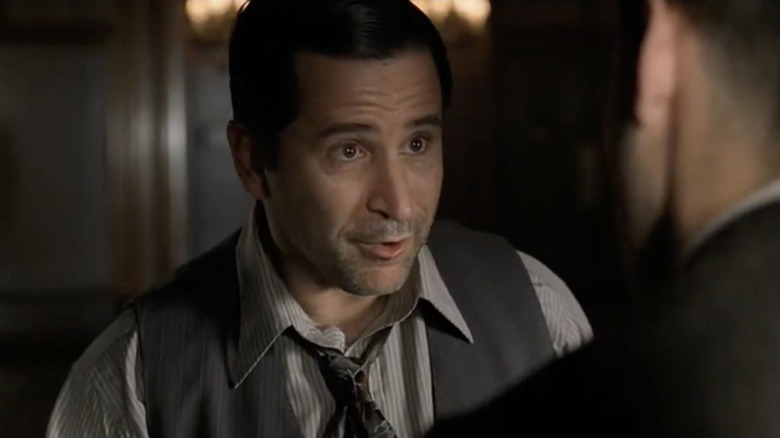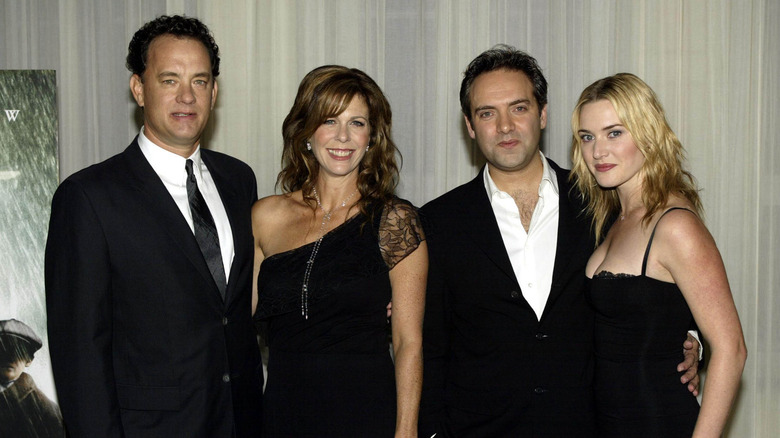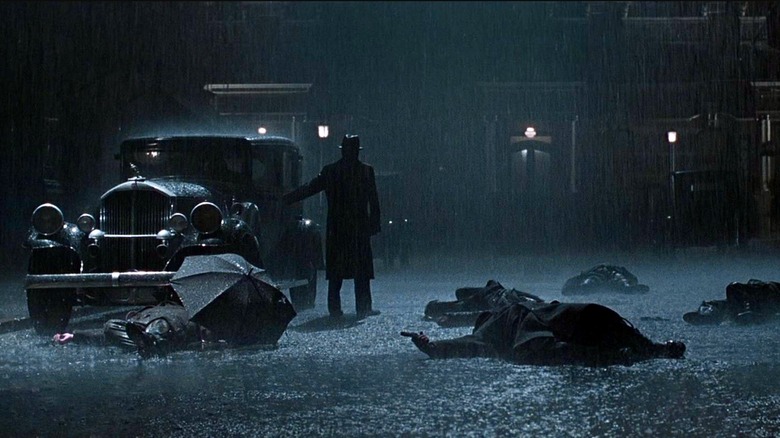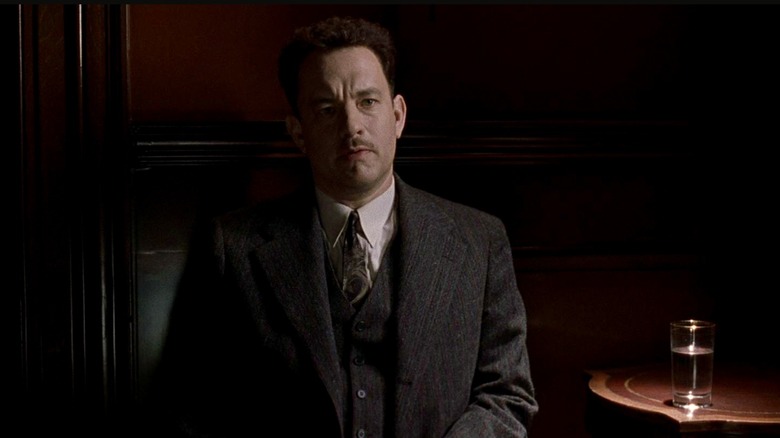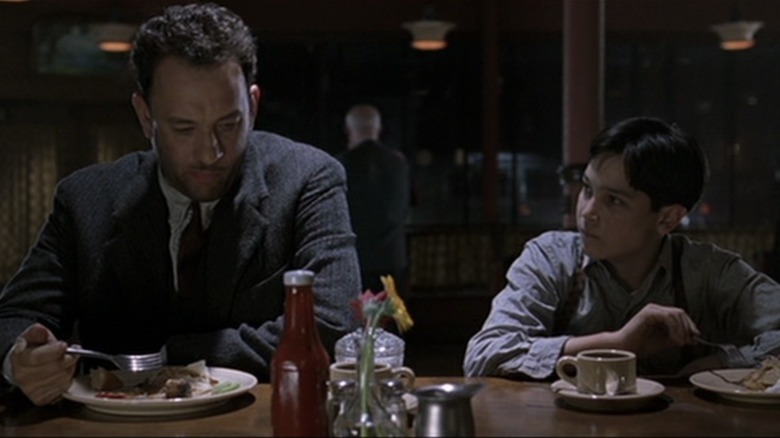Road To Perdition: Details Only Huge Fans Know About The Tom Hanks Hit
Sam Mendes' sophomore endeavor, "Road to Perdition," may have not garnered the incredible Oscar buzz of his directorial debut "American Beauty," but the 2002 pic still boasted a highly lauded, award-winning cast and crew. The pic, an elegiac gangster film, explored the complexity of the father-son bond and the lengths some fathers go to protect their sons.
In the film, after 12-year-old Michael Jr. (Tyler Hoechlin) witnesses his father Michael Sullivan Sr. (Tom Hanks) and Connor Rooney (Daniel Craig), murder an associate and his bodyguards, Michael Jr. finally understands his father is a mob enforcer for John Rooney (Newman). This incident endangers their family when Connor decides to kill everyone, including Sullivan's wife Annie (Jennifer Jason Leigh) and their youngest child Peter (Liam Aiken). Their murders place Sullivan and his remaining child, Micheal Jr. on the perilous road toward revenge.
"Road to Perdition" asks us to contemplate the effect violence has on the perpetrators, leading the audience to question what's the difference between vengeance, retribution, and justice. In an interview, Hanks contemplated this by asking, "Which one is it? It's an odd amalgam of those things. And what's really weird is they don't produce any joy, which I think is a very mature undertaking." Join us as we explore details only huge fans know about the Hanks hit.
Road to Perdition is an adaptation of a graphic novel
"Road to Perdition" was based on writer Max Allan Collins and illustrator Richard Piers Rayner's graphic novel. In a documentary, director Sam Mendes said, "When I read it, that was my first response. This is a film. It's meant to be a film. It speaks in images, not in dialogue." The screenplay went through a metamorphosis. In an interview, Tom Hanks shared how his character is called the Angel of Death in the graphic novel, saying it "was extremely violent. But Sam wasn't interested in making that kind of movie. And quite frankly, neither was I."
According to Entertainment Weekly, Hanks and cinematographer Conrad Hall were adamant the violence in the film would not be gratuitous. Script rewrites stripped much of the gore from the graphic novel away. In the film, darkness or distance obscured some murders, such as when Michael Jr. witnesses a murder while spying on his father. Likewise, other murders take place off-camera, as happens when Annie and Peter are killed, and Michael Jr. sees the flashes of gunfire from the street below the bathroom window.
Hall told Entertainment Weekly, "Sam knows I hate violence. But he promised he would minimize the blood." Mendes' restraint was apparent even when Connor meets his end. We only see what Sullivan has done to Connor in a POV shot when the bathroom door swings closed, reflecting Connor lying dead in the bathtub with his brains sprayed on the wall behind his head.
John Rooney was loosely based on John Patrick Looney
Although Michael Sullivan Sr. and his son are fictional characters, as reported by MovieWeb, John Rooney and his son Connor were loosely based on the mobster John Patrick Looney, whose son was also named Connor. According to The History Guy, Looney was a key figure in the criminal underworld and known as the Quad Cities Vice Lord. Looney controlled bootlegging, brothels, illegal gambling, and racketeering in the area surrounding Rock Island, along the Mississippi River and the Illinois-Iowa border.
According to NBC News, Looney started out life on a more traditional path to success by practicing law and taking part in local politics before starting a local newspaper. A bribery and extortion indictment in 1897 and the subsequent scandal suggest that despite appearances, Looney was already dabbling in illegal enterprises before the turn of the century. Because of this scandal, Looney temporarily moved to New Mexico, but returned to Rock Island, Illinois, in 1921 to rebuild his crime syndicate.
Looney's fate differed from Rooney's in the film, but Connor's fate in reality and the film were equally grim. According to The History Guy, Connor was gunned down in his car during an attempt on Looney's life, perhaps inspiring Rooney's fate in the film. Looney, as reported by NBC News, spent 14 years in prison for murder and died of tuberculosis more than a decade after he was released. Unlike in "Road to Perdition," Looney's criminal organization preceded Capone's prohibition-era enterprise.
Road to Perdition was cinematographer Conrad L. Hall's swan song
"Road to Perdition" was the second film Hall worked on as director of photography with Sam Mendes. Hall won his second Academy Award for best cinematography for Mendes' directorial debut, "American Beauty." In a documentary about the making of "Road to Perdition," Hall said of Mendes, "Such a great director, and when he was going to do another film, I said, 'You know, I'm with you.'" Unfortunately, this was the last feature film this lauded cinematographer made.
Hall died six months after the film's theatrical release. As reported by The Washington Post, Hall died in Santa Monica, California, of bladder cancer at 76 in January 2003. Hall was born in Tahiti, studied film at USC, and was inspired by French New Wave Cinema. Even after many decades of working as a director of photography, Hall was still excited by his trade, saying, "Cinematography is a brand-new language that is still developing."
Hall won a posthumous Academy Award for best cinematography for "Road to Perdition," which his son accepted. This last award gave Hall a grand total of three Oscars and seven additional Academy Award nominations during his career in filmmaking. In the documentary, Mendes spoke of Hall, saying, "I kind of relished every day that I had with him, because, you know, I think he's a master, and I think that cinematographers like that, come along two or three a generation."
Road to Perdition was Paul Newman's last live-action feature film role
When Film Monthly asked if "Road to Perdition" was his swan song, Paul Newman replied, "No, it's probably closer to a vulture than a swan song. I keep trying to retire from everything and discovered I've retired from absolutely nothing." Newman was nominated for best supporting actor for his performance as Mob boss John Rooney and continued doing voice work, including voicing Doc Hudson in the "Cars" movie and video games. Newman also joined the cast of one TV movie and one TV miniseries in his golden years, but "Road to Perdition" was Newman's last live-action feature film role.
When "Road to Perdition" was being promoted, Newman told Film Monthly, he always insisted on rehearsals, saying, "You discover a lot of things on your feet and if you don't have any rehearsal then anything that happens on the screen is by accident." Newman's consummate professionalism impressed his co-stars. Jude Law told Entertainment Weekly, "The opportunity to just sit and watch Paul Newman work was just joyous." On Dax Shepherd's podcast "Armchair Expert," Tom Hanks admitted he experienced imposter syndrome while working with the Newman on "Road to Perdition," suggesting both successful leading men were a little star-struck by their legendary co-star.
The piano duet between Mike Sullivan and Mob boss John Rooney was originally a dance scene
According to Paul Newman, in a 2002 interview with Entertainment Tonight, neither Hanks nor Newman could dance so this scene, depicting the strong familial bond between Mike Sullivan and his surrogate father John Rooney, became a piano duet instead of a dance sequence at the Irish wake. Newman told Film Monthly, "The piano was very fun and we worked very hard at it actually because it's not really about playing the piano. It's about doing something together. And that was fun."
During the director's commentary, Mendes talked about how Newman and Hanks practiced the piano together throughout the production of the film. Cinematographer Hall was careful to include both the faces and hands of Hank and Newman in a panning shot, making it clear this was something the two actors actually performed together. This scene not only shows us how close Rooney and Sullivan are but when the camera pans to their audience and rests on Conner, his smirk reveals his jealousy, suggesting Rooney is closer to his foster son Mike Sullivan than his biological son Connor.
The opening of the film was recut multiple times
Before Sam Mendes landed on starting "Road to Perdition" with Micheal Jr. standing on the beach looking across lake Michigan, at one point the opening sequence was Sullivan putting together the tommy gun while preparing to kill Rooney.
At the beginning of the director's commentary, Mendes spoke about how the beginning of this film was "the most difficult and contentious parts of the movie to cut." Ultimately, Mendes thought the image of the gun looming over the entire film was too dark and started the film with Micheal Jr. standing on the beach alone. Mendes said this choice makes the entire film a flashback, "populated entirely by ghosts." In the director's commentary, he speaks about how this beginning allowed space for the voiceover that bookends the film and shares how it was added shortly before the first screenings. In the director's commentary, Mendes also shares how he believes the score of the film intensifies this haunted quality.
The photographs on Maguire's walls were genuine photographs of dead bodies
During Sam Mendes' director's commentary for "Road to Perdition," he shared that the photographs hanging on the walls of Maguire's (Jude Law) apartment were real period photographs taken by a Chicago police photographer. Mendes said sometimes, the photographer posed the bodies to make the photograph's composition more appealing, saying, "strangely all of them are very beautiful, and yet quite shocking."
Mendes said they based Law's character on the man who took those photos, making him an unsettling character who is more disturbing than the mobsters who kill so efficiently. According to Entertainment Weekly Maguire was not included in the graphic novel, but was an original character in the film. Maguire seems to not only relish killing but enjoys making death into art, while Sullivan is simply good at killing despite finding no joy in it.
Law told Entertainment Weekly, "On the page, it was clear this guy had to have a hell of an effect on the audience. Instead of big, butch, and invincible, I wanted to make him a rodent." Some, including Mendes, have noted that this role was a make-under for Law, who was famous for his good looks as much as his talent. This performance certainly proved Law was just as capable of being a leading man as he was of stepping into the role of a character actor in an ensemble cast.
The roadside diner location was bought on the internet for $20,000
In the director's commentary, Sam Mendes revealed that the roadside diner location where Sullivan has his first interaction with Maguire was bought on the internet for $20,000 and was located approximately an hour outside of Chicago. Mendes said the film's production designer refurbished it and placed it in an open field they had scouted. Mendes called the image of the diner in an open field, "a truly opera-esque image of bleak beauty."
Much of "Road to Perdition" was shot on location in Chicago and the surrounding area, including additional locations in Indiana and Michigan. In a documentary about the making of "Road to Perdition," Mendes and production designer Dennis Gassner spoke about the myriad of locations in the greater Chicago area that contributed to creating the period imagery they needed to create their world. The frigid midwestern winter also added to the gloomy atmosphere of the film, contributing to anchoring the story in the Great Depression.
Frank Nitti's office was designed to look like the head of DreamWorks
According to Film School Rejects, Frank Nitti's (Stanley Tucci) Chicago office was an actual found office, not a set, and the office was designed to resemble DreamWorks' head Jeffrey Katzenberg's office. Nitti is another character based on a real person. Nitti was Al Capone's, right-hand man. According to Britannica, Nitti inherited Capone's criminal organization when Capone went to prison, but Nitti committed suicide in 1943 hours before an extortion indictment.
As reported by CBS News, Tucci was initially hesitant to take on the role, saying "I was a little reticent at first because of the gangster thing — but the script was so intelligent, beautifully written, and in Sam's hands, it would be artfully done." Tucci prepared for the role by reading about Nitti, stressing that the film isn't really a gangster movie, saying, "I think it's about relationships — unmasking and coming to terms with one's true self."
Many scenes were cut from the film for a shorter running time
Many of Jennifer Jason Leigh's scenes were filmed later in the production. In the director's commentary, Mendes said, "I felt, if we were to miss her when she died, we needed to see there was a relationship there, and there was very little time to establish that." Unfortunately, many of these scenes were cut, leaving the film with very little feminine influence. Mendes was sorry to cut the scenes but ultimately deemed it necessary because he felt like it took too long to get to the key plot development of Annie and Peter's murder.
After Sullivan and Michael Jr. have robbed Mob banks, there is a second diner scene. Jennifer Jason Leigh's sister, Mina Badie, played the waitress. Sullivan talks with the waitress while Michael Jr. is in the bathroom, explaining that his wife had recently died. In the deleted scenes commentary, Mendes talked about how this scene shows how much Sullivan misses his wife, but the scene was cut for time.
A scene including Al Capone, played by Anthony LaPaglia, was filmed with Paul Newman, Stanley Tucci, and Jude Law, but it was cut. In the deleted scenes commentary, Mendes said he felt Capone added a wild presence to the scene. Upon reflection, Mendes thought Capone took on a more mythic stature if we never saw him, despite his presence looming over his criminal organization. Much like the Great and Powerful Oz had more presence behind the curtain.
DreamWorks had hoped to release the film as a Christmas prestige piece
DreamWorks originally intended to release the film for the Christmas holiday, but Mendes, who is known in the industry as a perfectionist, asked for more time, and the film was released in July amidst the summer blockbuster season playing against movies like "Minority Report" and "The Bourne Identity." At that time, Jim Tharp, the studio's head of distribution, told Entertainment Weekly, "It's a counter-programming move."
Tharp believed the film would still impress despite audiences being primed for a blockbuster, saying, "There's a place for the popcorn movies, but certainly there's a need for this kind of movie, too." Tharp was right. Only "Men in Black II" and "Austin Powers in Goldmember" did better at the box office than "Road to Perdition" in July 2002. DreamWorks certainly scored in the prestige department with this film. Mendes' second film garnered five Academy Award nominations and one win.
In the graphic novel, Rooney's death scene is in a professional boxing ring
In the director's commentary, Sam Mendes explained how Rooney's death in the graphic novel and the original script took place in a boxing ring in front of a crowd, but Mendes wanted the sequence to be more dreamy. Mendes achieved this nightmarish interlude by accompanying the images with dreamy music and shooting it on the street where Sullivan is obscured by heavy rain before emerging from the darkness to gun Rooney down while people watch from their windows in the apartments above.
This scene is pivotal because Sullivan finally accepts he must kill his surrogate father after learning Rooney was protecting Connor despite knowing Connor was stealing. Sullivan believes Rooney and Connor must die to avenge Annie and Peter's deaths and to protect his remaining son Michael Jr. When Rooney tells Sullivan, "I'm happy it's you," there is some kind of recognition that Rooney accepts his death and is glad it is his foster son who takes him out.
Early in the director's commentary, Mendes talked about how the sound of water accompanies all the major murder scenes. With the Catholic imagery and symbolism throughout the film, water being associated with the murder scenes suggests some kind of baptism or transformation is taking place during these scenes. The violence changes the people who witness it and the people who perpetrate it.
This film was a rare opportunity for Tom Hanks to explore his dark side
Hanks is known for playing the hero, or everyone's favorite dad, but "Road to Perdition" was a chance for Hanks to play against type, exploring the more shadowy aspects of human nature as a mob enforcer who doesn't relish violence, but doesn't shy away from it either. "I just got this guy," Hanks told Entertainment Weekly, "If you're a man, and you've got offspring — emotionally, it's devastating." Of course, the audience ultimately identifies with Sullivan because he uses this terrible talent to protect his child whose only sin was curiosity and a desire to be closer to his father.
During a documentary about the making of the film, Sam Mendes said, "What's exciting to me about all these people is, they're cast against type." Mendes found it satisfying to give Hanks an opportunity to explore an archetype he had never played before, especially when Hanks was so invested. During the same documentary, Hanks revealed he was surprised that he knew exactly what to do with this character, despite Sullivan being so different from the characters he played in the past.
Sam Mendes was drawn to the project because of complex the father-son dynamics
"Road to Perdition" is about two sets of fathers and sons who are emotionally distant, but when it comes down to it, blood protects blood no matter the circumstances. During the director's commentary, Sam Mendes said, "One of the things that appealed to me early on was the fact that, in many ways, it's about two fathers, Rooney and Sullivan, who are forced into protecting their least favorite son."
At the beginning of the film, Sullivan is distant from his family because of his work as a Mob enforcer. Mendes explained to Entertainment Weekly, "We hold the man at arm's length from the audience for the first half hour. We put the audience in the shoes of the boy who doesn't understand his father." It is Micheal Jr.'s curiosity about what his father does for Mr. Rooney that leads to the death of Annie and Peter. In the wake of their deaths, Micheal Jr. gains access to his father.
While speaking to AFI, Mendes revealed how the change from winter to spring represents the humanizing of Sullivan who chooses Michael Jr's safety over his attachment to Mr. Rooney. Mendes said, "In a way, the second half of the film is a battle for the soul of his son." In the end, Sullivan learns Michael Jr. isn't as much like him as he feared when the boy can't shoot Maguire. Sullivan dies happily, knowing his boy won't become a killer.
